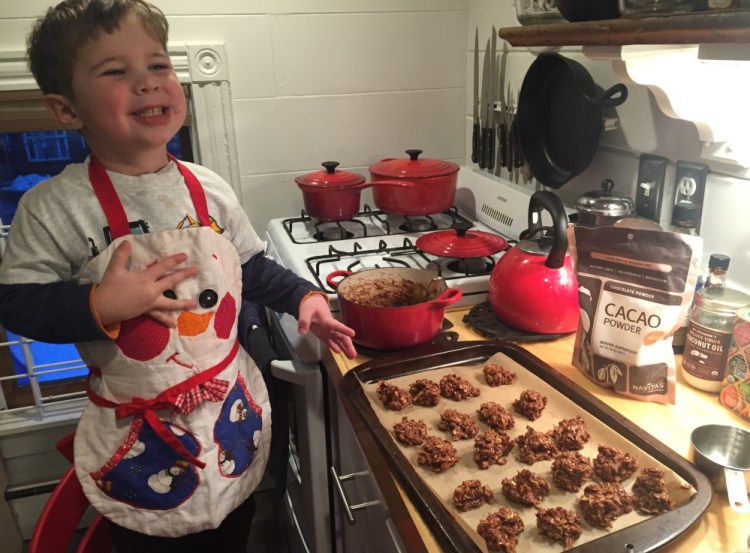“Wow! He’s big.”
Since my son was born three years ago, I’ve heard this phrase repeated by friends, family and strangers alike. How tall he is and how quickly he’s grown surprised me too, since some of the very limited research on vegan pregnancy points to the babies being born slightly below average in weight.
However, a couple of studies contradict that, pointing to vegan babies having a higher birth weight. With such scant data, I figured he had a good shot at being average.
In fact, my giant vegan baby was born a very average 7 pounds, 15 ounces. But at 22 1/2 inches long, he was considered tall for his age.
His birth weight put him in the 50th percentile, yet by 1 month he was in the 90th percentile, and since then he’s hovered at the 95th percentile or above for both height and weight.
In practical terms, this meant he was wearing size 24 months clothes at 6 months old. (So much for what I thought was a two-year stockpile of organic cotton clothing.)
His healthy growth rate may be relative – consider my husband, who at 6 feet, 3 inches towers over me. But as T. Colin Campbell, Ph.D. of the Center for Nutrition Studies frequently reminds people, genes don’t act alone.
In his influential 2006 book “The China Study,” Campbell writes: “Genes function only by being activated, or expressed, and nutrition plays a critical role in determining which genes, good and bad, are expressed.”
So how did I end up with a giant vegan baby?
Blame it on plant-strong, organic food.
Not only has my grass-fed (as my aunt calls him) 3-year-old never tried chicken nuggets, cow’s milk, tuna chunks or animal parts of any kind, he’s never eaten artificial sweeteners, colors or preservatives. He’s missed out on trans fats, dietary cholesterol and high-fructose corn syrup.
No one will be surprised that he’s never laid eyes on a Twinkie. But I’ve also never fed him Cheerios. (Yes, I am that hard-core of a health food mom.)
As a result, when my health food kid recently spotted goldfish crackers spilled on the ground at a festival, he didn’t recognize them as food. (Score!) The closest he’s gotten to candy is a vegan Clif Bar. The only birthday party cake and ice cream he knows is the organic, vegan variety.
You know me, I always buy organic, but when eating out or visiting family and friends, organic food isn’t always an option. In those cases, I steer him away from corn, soy, wheat and peanuts. All four crops can contain heavy amounts of applied glyphosate (commonly sold as Roundup) and other pesticides linked with the die-off of our crucial digestive microbes.
Turns out, my son is quite interested in these bacteria – or “creatures” as he calls them – and the whole, fibrous foods they like to eat and talks about them frequently. (“Mommy, do my creatures like kale?” “Yes, honey, they love kale.”)
By 6 months, my son didn’t yet know about these creatures but he was ready to start solids. So I got out my food mill, food processor and tiny glass storage containers.
First I gave him bits of soft foods, such as banana and very ripe fruits. Then I pureed single foods, such as millet, green beans and plums. Once he was used to purees, I moved onto combinations, including mujaddara (lentils, rice and caramelized onions); squash and garlic soup; roasted root vegetables; and maple-tamari glazed Brussels sprouts (that one didn’t go over so well, but I haven’t given up).
Soon he wanted finger foods, which meant cooked beans, cut fruit, steamed vegetables, whole grains, tofu cubes, whole wheat toast squares and bits of homemade falafel and veggie burgers.
When he was around a year old, I started introducing nuts, beginning with crushed-up versions and moving onto the softer, whole nuts such as walnuts, pecans and cashews.
By the time he was a year and a half, he began eating whatever I was making for dinner, with some important modifications.
Onions must be pureed rather than diced in all veggie burgers. Soft tacos must not contain anything other than beans and salsa. Two different foods shall never touch each other on the plate. Ever. And any lettuce or raw vegetables will remain untouched (if not contemptuously brushed off the plate and onto the table, OK, floor).
Speaking of vegetables and leafy greens, I have three favorite tricks: smoothies, soups and stir-fries.
A green smoothie is a 100 percent guaranteed way to get leafy greens into picky kids. I typically use kale or spinach (sometimes lettuce or chard), frozen, light-colored fruit (bananas, mangos, peaches, pineapple), ripe bananas (if I didn’t use frozen) and juice or water.
Soup is another excellent way to get green-averse eaters to consume some verdant vegetables. Every soup I make comes with a generous leafy green garnish – spinach with French lentil, cilantro with chili, and kale with Tuscan white bean.
I chop the greens fine, stir them into my son’s bowl before it reaches the table and when my son says, “Can I have mine without the green stuff?” I reply, “That’s how it’s made.”
He eats it anyway.
Stir-fry is another convenient pathway for getting all manner of vegetables into my little vegetarian, who is still learning to like vegetables. Kale, cabbage, carrots and broccoli stand up well in stir-fry. I always add baked tofu.
Like many a parent before me who has stir-fried for the preschool set, I’ve learned to do a minuscule dice.
When it comes to snacks, 99 percent of the time he enjoys fresh fruit, dried fruit and nuts. Dates are his favorite, and I always make sure I have some in the cupboard. I never leave home without a container of homemade trail mix.
About once a week, my son enjoys more processed snacks, such as Little Lad’s Herb Crackers, whole-grain muffins and organic spelt pretzels.
Lunch is typically leftover soup, veggie burgers (which I make and freeze) or sandwiches (such as hummus or cultured cashew cheese on whole-wheat bread, pickle on the side. No lettuce!).
Then there is the humble PB&J, a lunchbox staple especially dear to plant-strong families. With a quality whole-grain bread, natural, organic peanut butter and jam without refined sugar, I suddenly have a kid-pleasing, nutritious and totally portable lunch.
To get him to lunch, we pack in some serious nutrition during breakfast.
Each night before I go to bed, I soak 1 cup of whole oat groats in 3 cups water in a pot on the stove. In the morning, I turn the flame on medium high and boil the oats for about 30 minutes with the lid off until most of the water is absorbed and it’s a creamy porridge.
Then I add in the following superfoods: hemp seeds, crushed walnuts and ground flaxseeds. All three offer many health boosts, among them the beneficial fats, all nine essential amino acids and vital trace minerals (including magnesium, phosphorous and zinc) packed into a tiny seed.
From there, I add different flavor combinations, such as cinnamon-raisin, blueberry-raspberry and strawberry-soy milk. I always add Maine maple syrup.
Other hallmarks of my son’s diet include organic, unsweetened soy milk, daily fermented foods and home-cooked beans soaked in seaweed and nettle. (My son counts red beans and rice and mujaddara among his favorite foods.)
Eating vegan has a number of upsides, not least of which is the fact that he’s never had an ear infection or suffered constipation; both are linked to dairy consumption. His hair and nails are thick and glossy. He has tons of energy. And he doesn’t recognize candy in conventional grocery stores.
He also asks unusual questions, such as – when we’re passing the meat section in the grocery – “Mommy, are those dead animal parts?”
This fall he starts preschool and from there it will be the junk food-saturated world of kindergarten and grade school. Snack cakes, candy, meat and dairy will become more visible and real.
In the meantime, my child continues to grow. At 3, he’s already wearing sizes 5 and 6.
Of course, feeding a child organic, plant-based foods won’t guarantee a giant vegan baby. But it will give any child a head start in a world steeped with too many foods that harm rather than help.
Avery Yale Kamila is a freelance food writer who lives in Portland. She can be reached at:
avery.kamila@gmail.com
Twitter: AveryYaleKamila
Send questions/comments to the editors.



